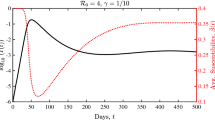Abstract
In this paper a class of functional–differential equations is considered, arising in modeling the dynamics of structured populations. This class includes model equations for diseases spreading by interactions of hosts, vectors and parasites considered in An (Drug Resistance in Infectious Diseases: Modeling, Analysis and Simulation, Doctoral thesis, University of Heidelberg, 2012) and An et al. (A structured population model for malaria including drug resistance. In preparation), where drug sensitive and drug resistant parasites and their effects on the infected host and vector populations are modeled via structural variables. In this paper, the evolution of n structured and m unstructured interacting populations is described by a coupled system of n functional–partial differential equations and m functional–ordinary differential equations. In general, besides initial conditions additional “boundary” conditions are required in order to determine missing data for the structure dependent variables. As the main result of this paper, we are going to present the analysis for the existence of unique, positive solutions.


Similar content being viewed by others
References
Ackleh, A.S., Ma, B.: A second-order high-resolution scheme for a juvenile-adult model of amphibians. Num. Funct. Anal. Optim. 34, 365–403 (2013)
An, L.T.T.: Drug resistance in infectious diseases: modeling, analysis and simulation. Doctoral Thesis, University of Heidelberg (2012)
An, L.T.T., Jäger, W., Neuss-Radu, M.: A structured population model for malaria including drug resistance. In preparation
Cusulin, C., Gerardo-Giorda, L.: A numerical method for spatial diffusion in age-structured populations. Num. Methods Partial Differ. Equ. 26(2), 253–273 (2010)
Deuflhard, P., Wulkow, M.: Computational treatment of polyreaction kinetics by orthogonal polynomials of a discrete variable. IMPACT Comput. Sci. Eng. 1, 269–301 (1989)
Diekmann, O., Gyllenberg, M., Metz, J.A.J., Thieme, H.R.: On the formulation and analysis of general deterministic structured population models. I. Linear theory. J. Math. Biol. 36, 349–388 (1998)
Diekmann, O., Gyllenberg, M., Huang, H., Kirkilionis, M., Metz, J.A.J., Thieme, H.R.: On the formulation and analysis of general deterministic structured population models, II. Nonlinear theory. J. Math. Biol. 43, 157–189 (2001)
Diekmann, O., Getto, P.: Boundedness, global existence and continuous dependence for nonlinear dynamical systems describing physiologically structured populations. J. Differ. Equ. 215, 268–319 (2005)
Diekmann, O., Getto, P., Gyllenberg, M.: Stability and bifurcation analysis of Volterra functional equations in the light of suns and stars. SIAM J. Math. Anal. 39, 1032–1069 (2007/2008)
Diekmann, O., Gyllenberg, M., Metz, J.A.J., Nakaoka, S., de Roos, A.M.: Daphnia revisited: local stability and bifurcation theory for physiologically structured populations models explained by way of an example. J. Math. Biol. 61, 277–318 (2010)
Fischer, T., Logashenko, D., Kirkilionis, M., Wittum, G.: Fast numerical integration for simulation of structured population equations. Math. Models Methods Appl. Sci. 16, 1987–2012 (2006)
Hadeler, K.P.: Vector-transmitted diseases in structured populations. In: Proceedings of International Workshop on Dynamical Systems and Environmental Models, Eisenach/GDR 1986, pp. 154–161 (1987)
de Roos, A.M.: Numerical methods for structurated populations models: the escalator boxcar train. Numer. Methods Partial Differ. Equ. 4, 174–195 (1988)
de Roos, A.M., Diekmann, O., Getto, P., Kirkilionis, M.: Numerical equilibrium analysis for structured consumer resource models. Bull. Math. Biol. 72, 259–297 (2010)
Sinko, J.W., Streifer, W.: A new model for age-size structure of a population. Ecology 48(6), 910–918 (1967)
Skakaukas, V.: A mathematical analysis of an age-sex-space-structured population dynamics model with random mating and females pregnancy. Informatica 9, 365–386 (1998)
Tucker, S.L., Zimmermann, S.O.: A nonlinear model of population dynamics containing an arbitrary number of continuous structure variables. SIAM J. Appl. Anal. 48, 549–591 (1988)
Webb, G.F.: Population models structured by age, size, and spatial position. In: Magal, P., Ruan, S. (eds.) Structured Population Models in Biology and Epidemiology. Lecture Notes in Mathematics, vol. 1936. Springer, Berlin (2008)
Acknowledgments
The research of L.T.T. An was partially supported by BIOMS (Center for Modeling and Simulation in the Biosciences), University of Heidelberg, Germany.
Author information
Authors and Affiliations
Corresponding author
Additional information
Dedicated to the memory of Prof. Klaus Kirchgässner.
Rights and permissions
About this article
Cite this article
An, L.T.T., Jäger, W. & Neuss-Radu, M. Systems of Populations with Multiple Structures: Modeling and Analysis. J Dyn Diff Equat 27, 863–877 (2015). https://doi.org/10.1007/s10884-015-9469-3
Received:
Revised:
Published:
Issue Date:
DOI: https://doi.org/10.1007/s10884-015-9469-3



